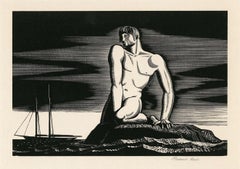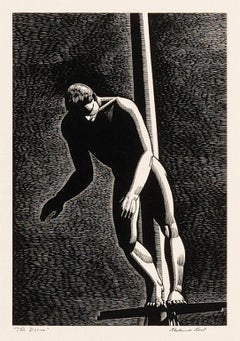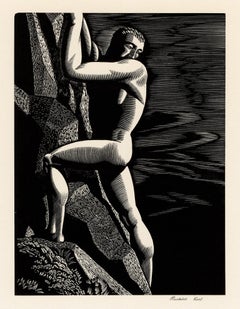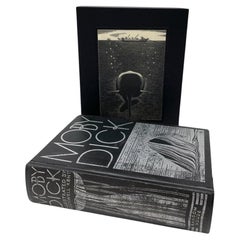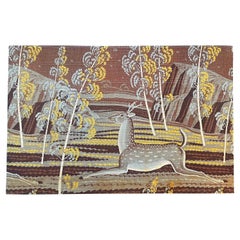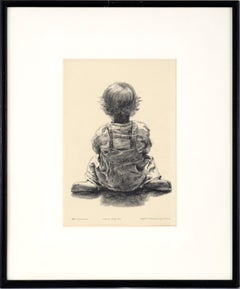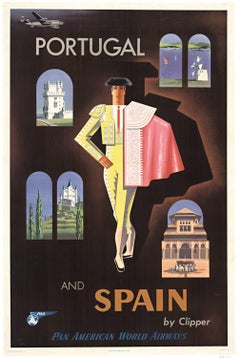Rockwell Kent Art
American, 1882-1971
Rockwell Kent, (1882-1971) was born in Plattsburgh, New York). As a painterand printmaker his work was captured scenes of nature and adventure with a sense of drama that made him one of the most popular American artists of the first half of the 20th century.
Kent studied architecture at Columbia University but turned to painting and was a pupil of William M. Chase, Robert Henri, and Abbott Thayer. Best known as an artist and illustrator he worked as an architectural draftsman, as a lobsterman and carpenter on the coast of Maine, and as a ship’s carpenter. He explored the waters about Tierra del Fuego in a small boat and lived in Newfoundland, Alaska, and Greenland, drawing heavily upon these experiences for his paintings and travel books. Kent’s human figures, which appear sparingly in his work, often signify mythic themes, such as heroism, loneliness, and individualism.to
18
18
14
12
2
1
1
1
1
'The Bather' — Iconic American Modernism
By Rockwell Kent
Located in Myrtle Beach, SC
Rockwell Kent, 'The Bather', wood engraving, 1931, edition 120, Burne Jones 63. Signed in pencil. A brilliant, black impression, on cream, wove Japan paper; the full sheet with margins (2 1/2 to 3 1/4 inches); slight skinning at the top sheet edge, verso, otherwise in excellent condition. Archivally matted to museum standards, unframed.
Image size 5 3/8 x 7 7/8 inches (137 x 200 mm); sheet size 11 1/8 x 14 1/2 inches (283 x 368 mm).
Impressions of this work are held in the following public collections: Burne Jones Collection (Illinois), Chazen Museum of Art, Chegodaev Collection (Moscow), Kent Collection (New York), National Gallery of Art, Philadelphia Museum of Art; SUNY Plattsburg Art Museum, Princeton University Library, Pushkin Museum (Moscow), Smithsonian American Art Museum, Spector Collection (New York), University of Illinois.
ABOUT THE ARTIST
Rockwell Kent (1882-1971), though best known as a painter, graphic artist, and illustrator, pursued many careers throughout his life, including architect, carpenter, explorer, writer, dairy farmer, and political activist. Born in Tarrytown, New York, Kent was interested in art from a young age. These ambitions were encouraged by his aunt Jo Holgate, an accomplished ceramicist. Jo came to live with the family after Kent’s father passed away in 1887 and took him to Europe as a teenager, undoubtedly kindling his interest in exploring the world.
Kent attended the Horace Mann School in New York City, where he excelled at mechanical drawing. His family’s financial circumstances prevented him from pursuing a career in the fine arts; however, after graduating from Horace Mann in 1900, Kent decided to study architecture at Columbia University.
Before matriculating at Columbia, Kent spent the first of three consecutive summers studying painting at William Merritt Chase’s art school in Shinnecock Hills, Long Island. There he found a community of mentors and fellow students who encouraged him to pursue his interest in art. At the end of Kent’s third summer at Shinnecock, Chase offered him a full scholarship to the New York School of Art, where he was a teacher. Kent began taking night classes at the art school in addition to his architecture studies but soon left Columbia to study painting full-time. In addition to Chase, Kent took classes with Robert Henri and Kenneth Hayes Miller, where his classmates included the artists George Bellows and Edward Hopper.
Kent spent the summer of 1903 assisting the eccentric painter Abbott Handerson Thayer at his studio in Dublin, New Hampshire—a position he secured through the recommendation of his Aunt Jo. Thayer’s naturalist lifestyle and almost mystical appreciation for natural phenomena greatly influenced Kent; he returned to Dublin for many years to visit Thayer and his family. Thayer gave the young artist time to pursue his work, and that summer Kent painted several views of the New Hampshire landscape, including Mount Monadnock...
Category
1930s American Modern Rockwell Kent Art
Materials
Woodcut
A Handsome 1930s Rockwell Kent Lithograph on Paper, Titled "Canterbury Tales"
By Rockwell Kent
Located in Chicago, IL
A handsome 1930s Rockwell Kent lithograph on paper, titled "Canterbury Tales". Nicely matted and framed in a gold-toned frame. Image size: ...
Category
1930s American Modern Rockwell Kent Art
Materials
Paper, Lithograph
'Diver' — 1930s American Modernism
By Rockwell Kent
Located in Myrtle Beach, SC
Rockwell Kent, 'Diver', wood engraving, 1931, edition 150, Burne Jones 88. Signed, and titled 'The Diver' in pencil.. A brilliant, black impression, on cream, wove Japan paper; the f...
Category
1930s American Modern Rockwell Kent Art
Materials
Woodcut
'Mountain Climber' — American Modernism
By Rockwell Kent
Located in Myrtle Beach, SC
Rockwell Kent, 'Mountain Climber', wood engraving, 1933, edition 250, Burne Jones 93. Signed in pencil. A brilliant, black impression, on cream, wove Japan paper; the full sheet with margins (2 9/16 to 3 5/8 inches); slight skinning at the top sheet edge verso, where previously hinged; otherwise, in excellent condition. Archivally matted to museum standards, unframed.
Image size 7 7/8 x 5 7/8 inches (200 x 149 mm); sheet size 14 x 11 1/8 inches (356 x 283 mm).
Printed by Pynson Printers, New York. Distributed by The Print Club of Cleveland, Publication No. 11, 1933.
Literature: 'Rockwellkentiana,' Harcourt, Brace and Company, New York, 1933. '101 of The World’s Greatest Books', edited by Spencer Armstrong, 1950.
Impressions of this work are held in the following museum collections: Akron Art Institute, Burne Jones Collection, IL; Cincinnati Art Museum; Cleveland Museum of Art; Columbus Gallery of Fine Arts; Crystal Bridges Museum of American Art; Davis Museum at Wellesley College; Fine Art Museums of San Francisco; H. M. de Young Museum; Hermitage Museum; Kent Collection, NY; Library of Congress; Memorial Art Gallery, University of Rochester; Metropolitan Museum of Art; New York Public Library; Philadelphia Museum of Art; Princeton University Library; Smithsonian American Art Museum, Spector Collection, NY; SUNY, Plattsburg.
ABOUT THE ARTIST
Rockwell Kent (1882-1971), though best known as a painter, graphic artist, and illustrator, pursued many careers throughout his life, including architect, carpenter, explorer, writer, dairy farmer, and political activist. Born in Tarrytown, New York, Kent was interested in art from a young age. These ambitions were encouraged by his aunt Jo Holgate, an accomplished ceramicist. Jo came to live with the family after Kent’s father passed away in 1887 and took him to Europe as a teenager, undoubtedly kindling his interest in exploring the world.
Kent attended the Horace Mann School in New York City, where he excelled at mechanical drawing. His family’s financial circumstances prevented him from pursuing a career in the fine arts; however, after graduating from Horace Mann in 1900, Kent decided to study architecture at Columbia University.
Before matriculating at Columbia, Kent spent the first of three consecutive summers studying painting at William Merritt Chase’s art school in Shinnecock Hills, Long Island. There he found a community of mentors and fellow students who encouraged him to pursue his interest in art. At the end of Kent’s third summer at Shinnecock, Chase offered him a full scholarship to the New York School of Art, where he was a teacher. Kent began taking night classes at the art school in addition to his architecture studies but soon left Columbia to study painting full-time. In addition to Chase, Kent took classes with Robert Henri and Kenneth Hayes Miller, where his classmates included the artists George Bellows and Edward Hopper.
Kent spent the summer of 1903 assisting the eccentric painter Abbott Handerson Thayer at his studio in Dublin, New Hampshire—a position he secured through the recommendation of his Aunt Jo. Thayer’s naturalist lifestyle and almost mystical appreciation for natural phenomena greatly influenced Kent; he returned to Dublin for many years to visit Thayer and his family. Thayer gave the young artist time to pursue his work, and that summer Kent painted several views of the New Hampshire landscape, including Mount Monadnock. In 1905 Kent moved from New York to Monhegan Island in Maine, home to a summer art colony, where he continued to find inspiration in nature. Kent soon found success exhibiting and selling his paintings in New York, and in 1907, he was given his first solo show at Claussen Galleries. The following year he married his first wife, Kathleen Whiting (Thayer’s niece), with whom he had five children. The couple divorced in 1924, and Kent married Frances Lee the following year. They divorced after 15 years of marriage, and the artist married Sally Johnstone.
For the next several decades, Kent lived a peripatetic lifestyle, settling in several locations in Connecticut, Maine, and New York. During this time he took several extended voyages to remote, often ice-filled, corners of the globe, including Newfoundland, Alaska, Tierra del Fuego, and Greenland, to which he made three separate trips. For Kent, exploration and artistic production were twinned endeavors, and his travels to these rugged, elemental locations inspired his visual art and his writings. He developed a stark, realist landscape style in his paintings and drawings that revealed both nature’s harshness and its sublimity. Kent’s human figures, which appear sparingly in his work, often allude to the mythic themes of isolation, individualism, heroism, and the quest for self-connection. Important exhibitions of works from these travels include the Knoedler Gallery’s shows in 1919 and 1920, featuring Kent’s Alaska drawings...
Category
1930s American Modern Rockwell Kent Art
Materials
Woodcut
Moby Dick by Herman Melville, Illustrated by R. Kent, First Trade Edition Thus
By Rockwell Kent
Located in Colorado Springs, CO
Melville, Herman. Moby-Dick. New York: Random House, 1930. Illustrated by Rockwell Kent. First trade edition (thus). Octavo. Original publisher’s pictorial black front cloth board, s...
Category
1930s American Art Deco Vintage Rockwell Kent Art
Materials
Fabric, Paper
"Deer Season", Rare Art Deco Fabric Designed by Rockwell Kent, circa 1950
By Rockwell Kent
Located in Philadelphia, PA
This rare and striking Art Deco fabric panel, featuring a running deer in a forest expressed in rich red and maize, was designed by Rockwell Kent for Bloomcraft Inc. in 1950. The de...
Category
1950s American Art Deco Vintage Rockwell Kent Art
Materials
Fabric
Blackhead, Monhegan Island, Maine
By Rockwell Kent
Located in New York, NY
At his teacher Robert Henri’s suggestion, Kent traveled to Monhegan Island, describing it as a “primordial universe”—a rugged, ancient landscape far removed from civilization. This e...
Category
20th Century Rockwell Kent Art
Materials
Oil, Board
Rockwell Kent Original Wood Engraving, 1931 - Diver
By Rockwell Kent
Located in Phoenix, AZ
Rockwell Kent (1882-1971) wood engraving in excellent condition titled: Diver.
Created 1931. Edition size: 150. Image measures: 7 7/8"h x 5 3/8"w.
The print is unframed and presents ...
Category
Mid-20th Century Rockwell Kent Art
Materials
Paper
N by E by Rockwell Kent, First Trade Edition in Dust Jacket, 1930
By Rockwell Kent
Located in Colorado Springs, CO
Kent, Rockwell. N by E. New York: Brewer & Warren, 1930. Printed by Lakeside Press, Chicago. First trade edition. In the publisher's original beige cloth boards, embossed in navy blu...
Category
1930s American Arts and Crafts Vintage Rockwell Kent Art
Materials
Paper
'Sea And Sky' — 1930s Modernism
By Rockwell Kent
Located in Myrtle Beach, SC
Rockwell Kent, 'Sea and Sky', wood engraving, edition 150, 1931 (published 1932). A brilliant, richly-inked impression on cream wove Japan; the full sheet with margins (2 to 2 1/2 in...
Category
1930s American Modern Rockwell Kent Art
Materials
Woodcut
HAIL AND FAREWELL
By Rockwell Kent
Located in Portland, ME
Kent, Rockwell. HAIL AND FAREWELL. Burne-Jones 55. Wood engraving, 1930. Edition of 120. 8 x 5 1/2 inches, 203 x 140 mm. Signed in pencil. In excellent condition.
Category
1930s American Modern Rockwell Kent Art
Materials
Woodcut
The Leaves of Grass by Walt Whitman, Illustrated by Rockwell Kent, Easton Press
By Walt Whitman, Rockwell Kent
Located in Colorado Springs, CO
Whitman, Walt. The Leaves of Grass. Norwalk: Easton Press, 1977. The 100 Greatest Books Ever Written. Collector's Edition. Illustrations by Rockwell Kent. Bound in original full gree...
Category
1970s American Modern Vintage Rockwell Kent Art
Materials
Leather, Silk, Paper
Rockwell Kent, Four Bookplates (on one sheet)
By Rockwell Kent
Located in New York, NY
Proof sheet with four wood engraved book plates by Rockwell Kent. Possibly for a book on this subject published in 1937. There are pencil numbers under each image that probably indic...
Category
Early 20th Century Art Deco Rockwell Kent Art
Materials
Woodcut
Chase Art Deco Chrome Champagne Ice Bucket Lurelle Guild Rockwell Kent Design
By Chase Brass and Copper Company, Rockwell Kent
Located in Chicago, IL
This chrome-plated champagne bucket has a Classic Art Deco style. The top edge is stepped and trimmed with a ribbed band; the front is adorned with a decorative plaque depicting Bacc...
Category
1930s American Art Deco Vintage Rockwell Kent Art
Materials
Chrome
Thomas Maitland Cleland, Signed 1929 Lithograph by Rockwell Kent
By Rockwell Kent
Located in Long Island City, NY
Thomas Maitland Cleland by Rockwell Kent, American (1882–1971)
Date: 1929
Lithograph, signed in pencil
Image Size: 9.5 x 7 inches
Size: 12 x 10 in. (30.48 x 25.4 cm)
Category
1920s American Modern Rockwell Kent Art
Materials
Lithograph
Rare Rockwell Kent for Chase Bacchus Art Deco Copper Cigarette Box
By Rockwell Kent, Chase Brass and Copper Company
Located in St. Louis, MO
Rockwell Kent (American, 1882-1971) Rare Bacchus Art Deco copper cigarette box for Chase Chrome & Brass company, only offered in 1935 and 1936.
Rockwell Kent designed only three items for chase, all with the same young Bacchus motiff, and all are considered rare today. The other two were a "Wine cooler" and "Wine bottle stand...
Category
1930s American Art Deco Vintage Rockwell Kent Art
Materials
Copper
American Art Deco Chrom Champagne Bucket
By Chase Brass and Copper Company, Rockwell Kent
Located in Queens, NY
American Art Deco chrome plated champagne bucket with geometric shape & fluted trim with ring handles; panel with figure & 2 deer designed by Rockwell Kent (CHASE) (Ref: Magazine Ant...
Category
1930s American Art Deco Vintage Rockwell Kent Art
Materials
Chrome
Hail and Farewell
By Rockwell Kent
Located in Missouri, MO
Rockwell Kent
"Hail and Farewell" 1930
Wood Engraving on Paper
Signed in Pencil Lower Right
Sheet Size: 14 3/8 x 11 1/4 in.
Image Size: 8 x 5 1/2 in.
Framed Size: 17.5 x 13.5 in.
Growing up in a genteel family in New York City, Rockwell Kent was a member of the rugged realist school of landscape painters as well as a popular illustrator and printmaker. His 1930 illustrations for Moby Dick are among his most lasting achievements. He was the first American artist to have work exhibited in the Soviet Union, a reflection of his Communist Party sympathies, which earned him the Lenin Peace Prize in 1967. This espousal of radical politics caused his career to suffer badly in the '50s because his leftist views caused him disdain among many Americans. However, his work, reflecting both realism and modernism, has earned increasing attention from American art historians.
His subject matter is wide-ranging including scenes of Maine's Monhegan Island, the Adirondack Mountains, book illustrations, and commercial art renderings for companies including General Electric, Rolls Royce, and Westinghouse. Although his first love was painting, in addition to illustration, he also did fabric, ceramic, and jewelry designs, and spent time as a dairy farmer, carpenter, home builder, and lobster fisherman...
Category
1930s American Modern Rockwell Kent Art
Materials
Woodcut
Price Upon Request
Related Items
"The Little One" - Rare Signed Figurative Lithograph in Ink on Paper
Located in Soquel, CA
"The Little One" - Figurative Lithograph in Ink on Paper
Bold lithograph by Eugene Hawkins (American, b. 1933). A young child is kneeling, facing away ...
Category
1960s American Modern Rockwell Kent Art
Materials
Paper, Ink, Lithograph
$675
H 20.75 in W 16.75 in D 0.5 in
Original Pan American World Airways by Clipper to Portugal and Spain poster
By Jean Carlu
Located in Spokane, WA
Original vintage poster: Portugal and Spain by Pan American World Airways Clipper, Artist: Jean Carlu. Pan American original vintage poster large travel size format 27.5" x 41.1" Earliest version (the 1950s) of the poster for travel by Constellation aircraft.
Original linen-backed, Pan American World Airways by Clipper vintage poster for travel to Portugal and Spain. Wear and stress marks in the top and bottom dark area but are not tears.. Small touch-up on the left white border.
In the middle of this image, it features a matador with a cape hanging off his shoulder. Surrounding the image in vignettes of cut-out windows showing typical landscape scenes and castles. A great smaller format original for "The World's Most Experienced Airline". One of the windmills shown in this image has cloth sails. Trimming the sails allowed the windmill to turn at near the optimal speed in a large range of wind velocities. Pan American World Airways by Clipper.
Pan American a.k.a. Pan Am Airlines posters are very collectible and rare year to year. This a great design opportunity for a home with a European flair. The Pan Am Clipper...
Category
1950s American Modern Rockwell Kent Art
Materials
Lithograph
$1,598
H 42 in W 27.5 in D 0.05 in
"Man Receiving Himself" By NY graphic artist Mury
Located in New York, NY
Mury (Mury Rabin)
Man Receiving Himself, c. 1960s
Softground monoprint
Sight: 16 1/2 x 18 1/4 in.
Framed: 23 1/8 x 25 1/8 x 7/8 in.
Titled lower right, signed lower left
Graphic ar...
Category
1960s American Modern Rockwell Kent Art
Materials
Monoprint
$750
H 23.125 in W 25.125 in D 0.875 in
neo-classical tapestry circa 1950
Located in Saint-Ouen, FR
neo-classical tapestry circa 1950
can be delivered without frame
Category
1950s French Louis XVI Vintage Rockwell Kent Art
Materials
Wool
Art Deco Tapisserie
Located in Antwerp, BE
Antique Art Deco velvet fabric. Persian style woven motif. Warm red, orange and black velvety surface. Dimensions: 257W x 135H cm.
Category
1930s Dutch Art Deco Vintage Rockwell Kent Art
Materials
Velvet
French Art Deco Tapestry
Located in New York, NY
French Art Deco tapestry
France, circa 1970s
Handwoven
Signed: Bleynie.
Category
Late 20th Century French Art Deco Rockwell Kent Art
Materials
Wool
Moby Dick or the Whale Easton Press 1977
Located in Newtown, CT
Moby Dick or the Whale by Herman Melville published by Easton press 1977. Leather book with gold gilt edges, archival quality paper. Part of the 100 Greatest Books ever written. Go...
Category
1970s American Modern Vintage Rockwell Kent Art
Materials
Leather, Paper
1 Volume. Charles Dickens. A Christmas Carol. First Rackham Trade Edition
Located in New York, NY
1 Volume. Charles Dickens. A Christmas Carol.
First Rackham Trade Edition. Bound in full red morocco, raised bands, ornate gilt on covers and spines, all edges gilt, marbled endpaper...
Category
20th Century English Rockwell Kent Art
Materials
Leather
$4,500
H 4 in W 6 in D 1.5 in
Original Algeciras Feria 1948 vintage Spanish travel lithograph poster
Located in Spokane, WA
Original vintage poster Algeciras Feria 1948 vintage Spanish travel poster. Archival linen backed in very fine condition, ready to frame. N...
Category
1940s American Modern Rockwell Kent Art
Materials
Lithograph
$1,080 Sale Price
20% Off
H 39.5 in W 27.75 in D 0.05 in
"Derriere Le Miroir, " Three Original Color Lithographs by Saul Steinberg
By Saul Steinberg
Located in Milwaukee, WI
"Derriere Le Miroir" is an original color lithograph signed by the artist Saul Steinberg. The artist's signature is in the bottom left margin.
Image Size: 14"x20"
Frame Size: 25 5/8...
Category
1970s American Modern Rockwell Kent Art
Materials
Lithograph, Paper
$10,900
H 25.63 in W 33.13 in
[Nude on Couch, Right Arm on Leg]
By Walt Kuhn
Located in New York, NY
Walt Kuhn (1877-1949), [Nude on Couch, Right Arm on Leg], c. 1920, etching, signed in pencil lower margin. In very good condition, traces of discoloration in...
Category
1920s American Modern Rockwell Kent Art
Materials
Etching
The Rhinegold and The Valkyrie Illustrated by A Rackham First Edition
By Wagner
Located in Dallas, TX
Presenting a fabulous first edition book, namely, The Rhinegold and The Valkyrie Illustrated by A Rackham First Edition.
The Rhinegol...
Category
Early 20th Century American Bohemian Rockwell Kent Art
Materials
Paper
$1,175
H 10 in W 7.5 in D 1.75 in
Previously Available Items
N by E by Rockwell Kent, Illustrated by Rockwell Kent, First Trade Edition, 1930
By Rockwell Kent
Located in Colorado Springs, CO
Kent, Rockwell. N by E. New York: New York Literary Guild, 1930. Printed by Lakeside Press, Chicago. First trade edition. In the publisher's original tan boards, embossed in green to...
Category
1930s American Art Deco Vintage Rockwell Kent Art
Materials
Fabric, Paper
H 8.57 in W 6.5 in D 1.44 in
The Lovers
By Rockwell Kent
Located in New York, NY
Wood engraving on Japan paper, 1928. Edition of 100. Signed by the artist in pencil, lower right.
Framed dimension is 14.5 x 17.25 inches, with full margins.
Catalogue raisonne r...
Category
Early 20th Century American Modern Rockwell Kent Art
Materials
Engraving, Woodcut
Rockwell Kent Etched Art Deco Brass Box
By Rockwell Kent
Located in Kilmarnock, VA
A stunning Art Deco box made out of brass with etched image by Kent made in 1928 for A.G. Spalding Bros, 52p Fifth Ave and executed by Chade Brass. The engraved image is of "Sally"...
Category
1920s American Art Deco Vintage Rockwell Kent Art
Materials
Brass
'Starry Night' — 1930s American Modernism
By Rockwell Kent
Located in Myrtle Beach, SC
Rockwell Kent, 'Starry Night' wood engraving, 1933, edition 1750, Burne Jones 103. Signed in pencil. A brilliant, black impression, on cream wove Japan paper; with margins (7/8 to 1 ...
Category
1930s American Modern Rockwell Kent Art
Materials
Woodcut
Moby Dick by Herman Melville, Illustrated by Rockwell Kent, 1930
By Rockwell Kent
Located in Colorado Springs, CO
Melville, Herman. Moby-Dick. New York: Random House, 1930. Illustrated by Rockwell Kent. First trade edition (thus). Octavo. Original publisher’s pictorial black cloth boards, stamped in silver. Original pictorial dust jacket. Presented with new archival ¼ leather and cloth clamshell case, with raised bands, gilt tooling and titles to spine.
Presented is a first trade edition (thus) of Moby-Dick; Or, the Whale by Herman Melville. First published in 1851, the book was reissued by Lakeside Press in 1930 in a three-volume limited edition, the first to feature Rockwell Kent's beautiful illustrations and limited to only 1000 copies. The limited edition quickly sold out and was followed by an equally popular one-volume trade edition, published later that year by Random House and printed by Lakeside Press. These two illustrated Rockwell Kent editions helped establish Moby-Dick as an American classic. The book featured here is the small format, one-volume first trade edition (thus), filled with Kent’s numerous illustrations. It is presented in the publisher’s original pictorial black cloth boards, stamped in silver, with the original illustrated dust jacket, and a new archival ¼ leather and clamshell case.
Herman Melville began writing Moby-Dick in February of 1850. In preparation for his book, Melville spent a substantial amount of time researching the whaling business on a whole. The historical ship, Essex, that was attacked by a sperm whale in 1820 was a major inspiration for much of Melville’s plot. Even the memorable name of the monstrous whale in the story is derived from a historically aggressive whale off the coast of Chile named Mocha Dick. Melville also drew inspiration from his own time as a sailor in the 1840s.
The book was first published in three volumes as The Whale in London in October 1851, by Richard Bentley. In November of that same year, it was published in New York under its definitive title, Moby-Dick; or, The Whale, in a single-volume edition by Harper and Brothers. Moby-Dick was not a critical or popular success in Melville’s lifetime. Fewer than 4,000 copies were sold and the book was decades out of print by the turn of the twentieth century.
The novel eventually received a positive reception from readers, literary figures, and critics in the 1920s. Most notably, biographer Raymond M. Weaver’s August 1919 article in The Nation, titled “The Centennial of Herman Melville,” and his subsequent full-length biography helped launch the “Melville Revival” of the 1920s. Moby-Dick was also well considered in critic Carl Van Doren’s discussion of “The American Novel” in 1921 and novelist D. H. Lawrence’s “Studies in Classic American Literature” in 1923. With the help of these 1920s literary tastemakers, Melville and Moby-Dick were rescued from historical obscurity and secured their place in the American literary canon.
As Moby-Dick came to be viewed as a great work of American literature, it started to appear in expensive editions geared toward collectors of rare and special books. When Lakeside Press decided to launch their "Four American Books" campaign, they reached out to painter and illustrator Rockwell Kent. Lakeside Press asked Kent to design an illustrated edition of Richard Henry Dana...
Category
1930s American Art Deco Vintage Rockwell Kent Art
Materials
Leather, Fabric, Paper
"Figure Study" Rockwell Kent, American Modernism, Work on Paper
By Rockwell Kent
Located in New York, NY
Rockwell Kent
Figure Study
Estate stamped lower right
Ink on paper
6 x 10 inches
Rockwell Kent, though best known as an artist and illustrator, pursued many careers throughout his long life, including architect, carpenter, explorer, writer, dairy farmer, and political activist. Born in Tarrytown, New York, Kent was interested in art from a young age. These ambitions were encouraged by his aunt Jo Holgate, an accomplished ceramicist. Jo came to live with the family after Kent’s father passed away in 1887 and took him to Europe as a teenager. Kent attended the Horace Mann School in New York City, where he excelled at mechanical drawing. His family’s financial circumstances prevented him from pursuing career in the fine arts, however, and after graduating from Horace Mann in 1900, Kent decided to study architecture at Columbia University.
Before matriculating at Columbia, Kent spent the first of three consecutive summers studying painting at William Merritt Chase’s art school in Shinnecock Hills, Long Island. There he found a community of mentors and fellow students who encouraged him to pursue his interest in art. At the end of Kent’s third summer at Shinnecock, Chase offered him a full scholarship to the New York School of Art, where he was a teacher. Kent began taking night classes at the art school in addition to his architecture studies, but soon left Columbia to study painting full time. In addition to Chase, Kent took classes with Robert Henri (American, 1865 - 1929) and Kenneth Hayes Miller (American, 1876 - 1952). His classmates included the artists George Bellows (American, 1882 - 1925) and Edward Hopper (American, 1882 - 1967).
Kent spent the summer of 1903 assisting the painter Abbott Handerson Thayer (American, 1849 - 1921) at his studio in Dublin, New Hampshire—a position he secured through the recommendation of his Aunt Jo. Thayer gave the young artist time to pursue his own work, and that summer Kent painted several views of the New Hampshire landscape, including Mount Monadnock. In 1905 Kent moved from New York to Monhegan Island in Maine, home to a summer art colony, where he continued to find inspiration in the natural world. Kent soon found success exhibiting and selling his paintings in New York and in 1907 was given his first solo show at Claussen Galleries. The following year he married his first wife, Kathleen Whiting (Thayer’s niece), with whom he had five children. The couple divorced in 1924, and Kent married Frances Lee the following year. They in turn divorced after 15 years of marriage, and the artist then married Sally Johnstone.
For the next several decades, Kent lived a peripatetic lifestyle, settling in several locations in Connecticut, Maine, and New York. During this time he took a number of extended voyages to remote, often ice-filled, corners of the globe, including Newfoundland, Alaska, Tierra del Fuego, and Greenland, to which he made three separate trips. For Kent, exploration and artistic production were twinned endeavors, and his travels to these rugged, rural locales provided inspiration for both his visual art and his writings. He developed a stark, realist landscape style in his paintings and drawings that revealed both nature’s harshness and its sublimity. Kent’s human figures, which appear sparingly in his work, often signify mythic themes, such as heroism, loneliness, and individualism. Important exhibitions of works from these travels include the Knoedler Gallery’s shows in 1919 and 1920, featuring Kent’s Alaska drawings...
Category
Early 20th Century Rockwell Kent Art
Materials
Paper, Ink
1938 "Books Make the Home" Print by Rockwell Kent
By Rockwell Kent
Located in Chapel Hill, NC
1938 "Books Make the Home" print by Rockwell Kent. American, 1882-1971. Signed in print & in pencil, lower right. Not examined out of frame. Image: 13 11/16" x 11 6/16". Frame: 21 3/...
Category
1930s Other Vintage Rockwell Kent Art
Materials
Paper
1930s Rockwell Kent Bacchus Copper Cigarette Box Chase Art Deco Relief Sculpture
By Chase Brass and Copper Company, Rockwell Kent
Located in Hyattsville, MD
"An incredibly rare piece of American Art Deco history. A "Bacchus" cigarette box designed by Rockwell Kent (American, 1882-1971) for the Chase Company. On...
Category
1930s American Art Deco Vintage Rockwell Kent Art
Materials
Copper
H 1.63 in W 6.5 in D 5.38 in
Man at Mast
By Rockwell Kent
Located in New Orleans, LA
A lookout starkly rendered in the art deco style straddles the mast of a ship as he surveys the landscape. Rockwell Kent's wood engraving issued in 1930 in an edition of 120. it is ...
Category
Early 20th Century American Modern Rockwell Kent Art
Materials
Wood, Engraving
'Mountain Climber' — 1930s American Modernism
By Rockwell Kent
Located in Myrtle Beach, SC
Rockwell Kent, 'Mountain Climber', wood engraving, 1933, edition 250, Burne Jones 93. Signed in pencil. A brilliant, black impression, on cream, wove Japan paper; the full sheet with margins (2 9/16 to 3 5/8 inches); in excellent condition. Image size 7 7/8 x 5 7/8 inches (200 x 149 mm); sheet size 14 x 11 1/8 inches (356 x 283 mm). Archivally matted to museum standards, unframed.
Printed by Pynson Printers, New York. Distributed by The Print Club of Cleveland, Publication No. 11, 1933.
Literature: 'Rockwellkentiana,' Harcourt, Brace and Company, New York, 1933. '101 of The World’s Greatest Books, edited by Spencer Armstrong, 1950.
Impressions of this work are held in the following museum collections: Akron Art Institute, Burne Jones Collection, IL; Cincinnati Art Museum; Cleveland Museum of Art; Columbus Gallery of Fine Arts; Crystal Bridges Museum of American Art; Davis Museum at Wellesley College; Fine Art Museums of San Francisco; H. M. de Young Museum; Hermitage Museum; Kent Collection, NY; Library of Congress; Memorial Art Gallery, University of Rochester; Metropolitan Museum of Art; New York Public Library; Philadelphia Museum of Art; Princeton University Library; Smithsonian American Art Museum, Spector Collection, NY; SUNY, Plattsburg.
ABOUT THE ARTIST
Rockwell Kent (1882-1971), though best known as a painter, graphic artist, and illustrator, pursued many careers throughout his life, including architect, carpenter, explorer, writer, dairy farmer, and political activist. Born in Tarrytown, New York, Kent was interested in art from a young age. These ambitions were encouraged by his aunt Jo Holgate, an accomplished ceramicist. Jo came to live with the family after Kent’s father passed away in 1887 and took him to Europe as a teenager, undoubtedly kindling his interest in exploring the world.
Kent attended the Horace Mann School in New York City, where he excelled at mechanical drawing. His family’s financial circumstances prevented him from pursuing a career in the fine arts; however, after graduating from Horace Mann in 1900, Kent decided to study architecture at Columbia University.
Before matriculating at Columbia, Kent spent the first of three consecutive summers studying painting at William Merritt Chase’s art school in Shinnecock Hills, Long Island. There he found a community of mentors and fellow students who encouraged him to pursue his interest in art. At the end of Kent’s third summer at Shinnecock, Chase offered him a full scholarship to the New York School of Art, where he was a teacher. Kent began taking night classes at the art school in addition to his architecture studies but soon left Columbia to study painting full-time. In addition to Chase, Kent took classes with Robert Henri and Kenneth Hayes Miller, where his classmates included the artists George Bellows and Edward Hopper.
Kent spent the summer of 1903 assisting the eccentric painter Abbott Handerson Thayer at his studio in Dublin, New Hampshire—a position he secured through the recommendation of his Aunt Jo. Thayer’s naturalist lifestyle and almost mystical appreciation for natural phenomena greatly influenced Kent; he returned to Dublin for many years to visit Thayer and his family. Thayer gave the young artist time to pursue his work, and that summer Kent painted several views of the New Hampshire landscape, including Mount Monadnock...
Category
1930s American Modern Rockwell Kent Art
Materials
Woodcut
Starry Night
By Rockwell Kent
Located in New York, NY
A very good, evenly-printed and dark impression of this wood engraving. Edition of 1750. Signed in pencil, lower right. Published by the Literary Guild of America.
Category
1930s American Modern Rockwell Kent Art
Materials
Engraving
CASANOVA - rare signed impression
By Rockwell Kent
Located in Santa Monica, CA
ROCKWELL KENT (1882 197)
CASANOVA , 1925
Wood engraving. Proof impression, signed in pencil, from the book “Memoirs of Jacques Casanova de Seingalt Aventuros” Image 7 ½ x 5 ¼ inc...
Category
1920s American Modern Rockwell Kent Art
Materials
Woodcut
Rockwell Kent art for sale on 1stDibs.
Find a wide variety of authentic Rockwell Kent art available for sale on 1stDibs. You can also browse by medium to find art by Rockwell Kent in woodcut print, lithograph, engraving and more. Much of the original work by this artist or collective was created during the 20th century and is mostly associated with the modern style. Not every interior allows for large Rockwell Kent art, so small editions measuring 4 inches across are available. Customers who are interested in this artist might also find the work of John French Sloan, Lawrence Wilbur, and Paul Landacre. Rockwell Kent art prices can differ depending upon medium, time period and other attributes. On 1stDibs, the price for these items starts at $850 and tops out at $17,500, while the average work can sell for $5,000.
